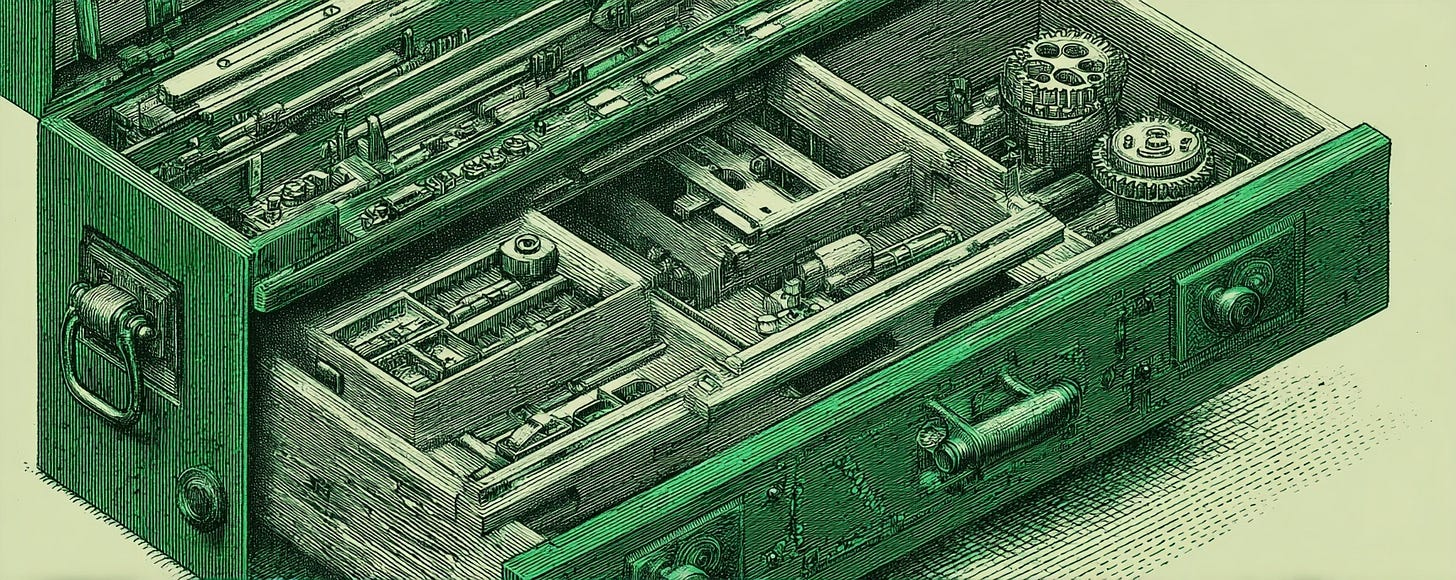Welcome to Curiously Chase
This newsletter is where three things converge:
Building reliable AI workflows that teams actually trust
Teaching builders to collaborate with AI, not just prompt it
Sharing practical lessons from five years building AI products in production
If you’re building with AI, leading teams adopting AI, or learning to work alongside AI…this space is for you.
What you’ll find here
AI workflow principles — Lessons from five years at Plumb building AI workflow automation and AI-augmented development tools. Structured outputs instead of hope-based parsing. Clear guardrails that prevent “AI did something weird” debugging sessions.
Practical prompts and patterns — The actual agent prompts, workflow designs, and techniques I use daily. It’s all based on what works for me in my workflows and production environments.
AI as collaborator, not tool — How to make AI feel like Spotify Discover Weekly or Netflix recommendations: you trust it without thinking, you might not even consider it AI, you just press play.
Some weeks, you’ll get a workflow breakdown with the exact prompt. Other times, it’s reflections on what makes AI workflows reliable or lessons from building teams where AI extends what small groups can accomplish.
No matter the format, you’ll find real, field-tested insights meant to help you build better with AI.
Who this is for
Engineering leaders — Building teams where AI is a collaborator rather than just a tool you reluctantly open in another tab.
AI builders — Learning to design workflows that feel like autocomplete.
Technical learners — Anyone who wants to collaborate with AI instead of copy-pasting code they can’t explain.
If you’re balancing the art of building, the evolution of AI tooling, and the discipline of creating reliable systems, you’re in the right place.
Who I am and why I write
I’m Chase Adams, co-founder of Plumb (2020-2025), where we built Murmur, Supermanage, and Plumb a distributed AI workflow tools that proved small, well-designed teams outperform larger ones when AI extends what they can accomplish.
Before that: I spent a decade at places like Zappos, Walmart Labs, and Webflow building teams and learning systems design. Before that: my family building supply business during the 2008 recession, using web development and SEO to expand from local to national.
I write this newsletter because the gap between “AI that transforms work” and “AI that creates more debugging sessions” is knowable, teachable, and learnable.
I want to close that gap by sharing what actually works.
What makes this different
In a sea of AI hype, this newsletter stands out by being:
Production-tested — Insights from building real AI products, not demos or experiments.
Practical and specific — The actual prompts, principles, and patterns. You can use them today.
Honest about trade-offs — What works, what doesn’t, and what I’m still figuring out.
Topics I Write About
This newsletter covers the real work of building reliable AI workflows, from both technical and human perspectives. The content is based on what I learned building AI-augmented development tools at Plumb and what I’m teaching in my course on collaborating with AI.
Here’s how I think about the topics I cover:
AI Workflow Principles
The patterns that make AI reliable. Structured outputs, clear guardrails, interfaces that feel obvious. I write about the mental models and design principles that separate trusted AI from chatbot steering.
Prompts and Agents
The actual prompts I use multiple times a day. Agent designs for newsletter curation, codebase mining, technical learning. Snippet prompts for adding work to periodic notes. All with metadata, categorization, and context.
AI-Augmented Development
How to build with AI as a collaborator. Learning conversation patterns, asking “why,” spotting red flags, pushing back when AI gives you something unclear. The goal: use AI without copy-pasting code you can’t explain.
Socio-Technical Architecture
How humans and AI collaborate in production systems. Workflow design that extends what small teams accomplish. Leadership evolution from builder to orchestrator. The shift from two-week cycles to 1-2 day cycles.
Applied AI Systems
Where AI meets the real world. What breaks, what surprises us, how to make it more reliable. Infrastructure decisions, constraint design, error handling that matters.
Teaching and Learning
How to collaborate with AI for learning technical topics. Effective communication patterns. Hands-on practice that builds understanding, not just working code.
If you care about clarity, systems, and doing meaningful work with AI tools that you actually trust, you’ll find something here for you.
Explore a Few Pieces
Here are a few of my greatest hits from my newsletter:
Four Flavors of AI—and When Each Tastes Like Failure — Not all AI is the same. This post breaks down the four major types of LLM-based interactions—Chat, Agent, Workflow, and Copilot—and shows how each solves a different kind of problem (and how they go wrong when misapplied).
When AI Automation Collides with Chaos — Before you automate, you need a real system. This piece explores the gap between ambition and reality—and how to turn messy processes into something AI can actually help with.
This 1 Trick Turned AI Code Fixes from Garbage to Gold — Linting errors and bad prompt loops can kill your flow. Here’s a practical fix: turn noisy tool output into repeatable prompt structures that actually produce useful code.
The Pink Elephant in the Room — Why telling AI what not to do often backfires—and how to reframe your prompts to avoid unintended results. A quick experiment that exposes a deep flaw in how language models process negation.
AI Isn’t Magic — A grounded take on AI’s real capabilities, and why being a technological pragmatist might be the most useful stance right now. Less hype, more clarity.
Your AI Chatbot Is Stuck in the Past—Here’s Why That Matters — The hidden cost of temporal drift in AI tools—and how it affects memory, context, and trust. If you’re building anything conversational, this one’s essential.
How AI Might Change the Way We Think — A reflective look at how AI shapes not just how we work, but how we form ideas, make decisions, and build things. It’s less about productivity, more about cognitive process.
Buried, Built, Reborn — A personal essay about going deep into the work, tearing down what didn’t fit, and emerging with a clearer sense of direction—for both product and self.
There’s more in the archive. Some are hands-on prompts. Others are workflow breakdowns. All of them come from real work, shared in real time.
I also write at curiouslychase.com and you can find deeper articles and essays like:
AI Workflow Principles — Eleven principles for building reliable, scalable AI workflows from five years at Plumb. The foundation of everything I teach about trustworthy AI.
Magic Mode - The Workflow Builder You Deserved — Not chat vs visual workflow builders—both together. Generate with prompts, see changes in green/red diffs, accept/reject modifications. Bridge between speed and precision.
AI-Augmented Note-Taking - Building a Second Brain That Actually Works — How Claude Code transformed note-taking from rigid systems into a discovery engine. AI scaffolding creates competitive advantage through pattern recognition.
Local AI Coding Tools — Comprehensive guide to AI-powered coding assistants that work with local files and integrate into development environments.
Rescuing Your Claude Conversations When You Rename Projects — CLI tool to safely rename project directories while preserving Claude Code conversation history and context.
There’s more in the archive. Some are hands-on prompts. Others are workflow breakdowns. All of them come from real work, shared in real time.
Subscribe if it feels right
If you’re building AI workflows, leading teams adopting AI, or learning to collaborate with AI in a more intentional way, this newsletter was made for you.
Subscribe to get practical, grounded insights from someone who spent five years making AI workflows reliable in production.
What to expect
New issues most weeks—no spam, no filler
Prompts, principles, and patterns you can use today
A focus on invisible AI that you actually trust
And yes, you can hit reply. I read every message.
Building AI workflows that teams trust,
Chase ✨🤘







